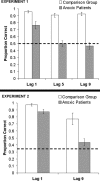The long and the short of it: relational memory impairments in amnesia, even at short lags
- PMID: 16899730
- PMCID: PMC6673802
- DOI: 10.1523/JNEUROSCI.5222-05.2006
The long and the short of it: relational memory impairments in amnesia, even at short lags
Abstract
Classic studies of amnesia led to characterizations of hippocampal function emphasizing involvement in long-term memory rather than short-term (or working) memory. In two experiments, we show that when memory for relations among co-occurring items is tested, hippocampal amnesia results in a deficit even at very short lags. Hence, we find evidence for hippocampal involvement in relational memory, even at short lags normally considered the province of working memory.
Figures



Similar articles
-
Processing and short-term retention of relational information in amnesia.Neuropsychologia. 2004;42(4):497-511. doi: 10.1016/j.neuropsychologia.2003.08.011. Neuropsychologia. 2004. PMID: 14728922
-
Memory for relations in the short term and the long term after medial temporal lobe damage.Hippocampus. 2017 May;27(5):608-612. doi: 10.1002/hipo.22716. Epub 2017 Feb 21. Hippocampus. 2017. PMID: 28188665 Free PMC article.
-
Integration of cognitive allocentric information in visuospatial short-term memory through the hippocampus.Hippocampus. 2005;15(8):1072-84. doi: 10.1002/hipo.20126. Hippocampus. 2005. PMID: 16161036
-
Amnesia and neglect: beyond the Delay-Brion system and the Hebb synapse.Philos Trans R Soc Lond B Biol Sci. 1997 Oct 29;352(1360):1481-8. doi: 10.1098/rstb.1997.0135. Philos Trans R Soc Lond B Biol Sci. 1997. PMID: 9368937 Free PMC article. Review.
-
The neurology of traumatic "dissociative" amnesia: commentary and literature review.Child Abuse Negl. 1999 Aug;23(8):715-27. doi: 10.1016/s0145-2134(99)00048-4. Child Abuse Negl. 1999. PMID: 10477233 Review.
Cited by
-
Selective maintenance in visual working memory does not require sustained visual attention.J Exp Psychol Hum Percept Perform. 2013 Aug;39(4):1047-58. doi: 10.1037/a0030238. Epub 2012 Oct 15. J Exp Psychol Hum Percept Perform. 2013. PMID: 23067118 Free PMC article.
-
Cholinergic modulation of the CAN current may adjust neural dynamics for active memory maintenance, spatial navigation and time-compressed replay.Front Neural Circuits. 2012 Mar 15;6:10. doi: 10.3389/fncir.2012.00010. eCollection 2012. Front Neural Circuits. 2012. PMID: 22435051 Free PMC article.
-
Beyond feature binding: interference from episodic context binding creates the bivalency effect in task-switching.Front Psychol. 2012 Oct 5;3:386. doi: 10.3389/fpsyg.2012.00386. eCollection 2012. Front Psychol. 2012. PMID: 23060846 Free PMC article.
-
VisMET: a passive, efficient, and sensitive assessment of visuospatial memory in healthy aging, mild cognitive impairment, and Alzheimer's disease.Learn Mem. 2019 Feb 15;26(3):93-100. doi: 10.1101/lm.048124.118. Print 2019 Mar. Learn Mem. 2019. PMID: 30770466 Free PMC article.
-
Concept neurons in the human medial temporal lobe flexibly represent abstract relations between concepts.Nat Commun. 2021 Oct 25;12(1):6164. doi: 10.1038/s41467-021-26327-3. Nat Commun. 2021. PMID: 34697305 Free PMC article.
References
-
- Allen J S, Tranel D, Bruss J, Damasio H (2006). Correlations between regional brain volumes and memory performance in anoxia. J Clin Exp Neuropsychol 28:457–476. - PubMed
-
- Althoff RR, Cohen NJ (1999). Eye-movement-based memory effect: a re-processing effect in face perception. J Exp Psychol Learn Mem Cogn 25:1–14. - PubMed
-
- Baddeley AP, Warrington EK (1970). Amnesia and the distinction between long and short-term memory. J Verb Learn Verb Behav 9:176–189.
-
- Buckley MJ, Gaffan D (2006). Perirhinal cortical contributions to object perception. Trends Cogn Sci 10:100–107. - PubMed
-
- Buffalo EA, Reber PJ, Squire LR (1998). The human perirhinal cortex and recognition memory. Hippocampus 8:330–339. - PubMed
Publication types
MeSH terms
LinkOut - more resources
Full Text Sources
